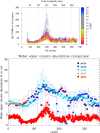Present-day thermal and water activity environment of the Mars Sample Return collection
- PMID: 38532041
- PMCID: PMC10965995
- DOI: 10.1038/s41598-024-57458-4
Present-day thermal and water activity environment of the Mars Sample Return collection
Abstract
The Mars Sample Return mission intends to retrieve a sealed collection of rocks, regolith, and atmosphere sampled from Jezero Crater, Mars, by the NASA Perseverance rover mission. For all life-related research, it is necessary to evaluate water availability in the samples and on Mars. Within the first Martian year, Perseverance has acquired an estimated total mass of 355 g of rocks and regolith, and 38 μmoles of Martian atmospheric gas. Using in-situ observations acquired by the Perseverance rover, we show that the present-day environmental conditions at Jezero allow for the hydration of sulfates, chlorides, and perchlorates and the occasional formation of frost as well as a diurnal atmospheric-surface water exchange of 0.5-10 g water per m2 (assuming a well-mixed atmosphere). At night, when the temperature drops below 190 K, the surface water activity can exceed 0.5, the lowest limit for cell reproduction. During the day, when the temperature is above the cell replication limit of 245 K, water activity is less than 0.02. The environmental conditions at the surface of Jezero Crater, where these samples were acquired, are incompatible with the cell replication limits currently known on Earth.
Keywords: Environment; Habitability; Jezero; Mars sample return; Temperature; Water activity.
© 2024. The Author(s).
Conflict of interest statement
The authors declare no competing interests.
Figures





Similar articles
-
Sampling Mars: Geologic context and preliminary characterization of samples collected by the NASA Mars 2020 Perseverance Rover Mission.Proc Natl Acad Sci U S A. 2025 Jan 14;122(2):e2404255121. doi: 10.1073/pnas.2404255121. Epub 2025 Jan 6. Proc Natl Acad Sci U S A. 2025. PMID: 39761398 Free PMC article.
-
Planning Implications Related to Sterilization-Sensitive Science Investigations Associated with Mars Sample Return (MSR).Astrobiology. 2022 Jun;22(S1):S112-S164. doi: 10.1089/AST.2021.0113. Epub 2022 May 19. Astrobiology. 2022. PMID: 34904892
-
Experimental Investigation of the Atmosphere-Regolith Water Cycle on Present-Day Mars.Sensors (Basel). 2021 Nov 8;21(21):7421. doi: 10.3390/s21217421. Sensors (Basel). 2021. PMID: 34770727 Free PMC article.
-
Preliminary Planning for Mars Sample Return (MSR) Curation Activities in a Sample Receiving Facility (SRF).Astrobiology. 2022 Jun;22(S1):S57-S80. doi: 10.1089/AST.2021.0105. Epub 2022 May 19. Astrobiology. 2022. PMID: 34904890 Review.
-
Astrobiological Potential of Fe/Mg Smectites with Special Emphasis on Jezero Crater, Mars 2020 Landing Site.Astrobiology. 2022 May;22(5):579-597. doi: 10.1089/ast.2021.0013. Epub 2022 Feb 15. Astrobiology. 2022. PMID: 35171004 Review.
Cited by
-
Sampling Mars: Geologic context and preliminary characterization of samples collected by the NASA Mars 2020 Perseverance Rover Mission.Proc Natl Acad Sci U S A. 2025 Jan 14;122(2):e2404255121. doi: 10.1073/pnas.2404255121. Epub 2025 Jan 6. Proc Natl Acad Sci U S A. 2025. PMID: 39761398 Free PMC article.
-
In situ crystallographic mapping constrains sulfate precipitation and timing in Jezero crater, Mars.Sci Adv. 2025 Apr 18;11(16):eadt3048. doi: 10.1126/sciadv.adt3048. Epub 2025 Apr 16. Sci Adv. 2025. PMID: 40238880 Free PMC article.
-
Ultraviolet and biological effective dose observations at Gale Crater, Mars.Proc Natl Acad Sci U S A. 2025 May 27;122(21):e2426611122. doi: 10.1073/pnas.2426611122. Epub 2025 May 12. Proc Natl Acad Sci U S A. 2025. PMID: 40354557
References
-
- Farley KA, Williford KH, Stack KM, Bhartia R, Chen AD, Torre M, Hand K, Goreva Y, Herd CDK, Hueso R, Liu Y, Maki JN, Martinez G, Moeller RC, Nelessen A, Newman CE, Nunes D, Ponce A, Spanovich N, Willis PA, Beegle LW, Bell JF, Brown AJ, Hamran S-E, Hurowitz JA, Maurice S, Paige DA, Rodriguez-Manfredi JA, Schulte M, Wiens RC. Mars 2020 mission overview. Sp. Sci. Rev. 2020 doi: 10.1007/s11214-020-00762-y. - DOI
-
- Kminek, G., Meyer, M. A., Beaty, D. W., Carrier, B. L., Haltigin, T., & Hays, L. E. Mars sample return (MSR): Planning for returned sample science. Astrobiology S1–S4. 10.1089/ast.2021.0198 (2022) - PubMed
-
- Czaja AD, Zorzano M-P, Kminek G, Meyer MA, Beaty DW, Sefton-Nash E, Carrier BL, Thiessen F, Haltigin T, Bouvier A, Dauphas N, French KL, Hallis LJ, Harris RL, Hauber E, Rodriguez LE, Schwenzer SP, Steele A, Tait KT, Thorpe MT, Usui T, Vanhomwegan J, Velbel MA, Edwin S, Farley KA, Glavin DP, Harrington AD, Hays LE, Hutzler A, Wadhwa M, Members of the Mars Sample Return Campaign Science Group (MCSG) Team Report of the science community workshop on the proposed first sample depot for the mars sample return campaign. Meteorit. Planet. Sci. 2023;1:1. doi: 10.1111/maps.13981. - DOI
Grants and funding
LinkOut - more resources
Full Text Sources
Miscellaneous

